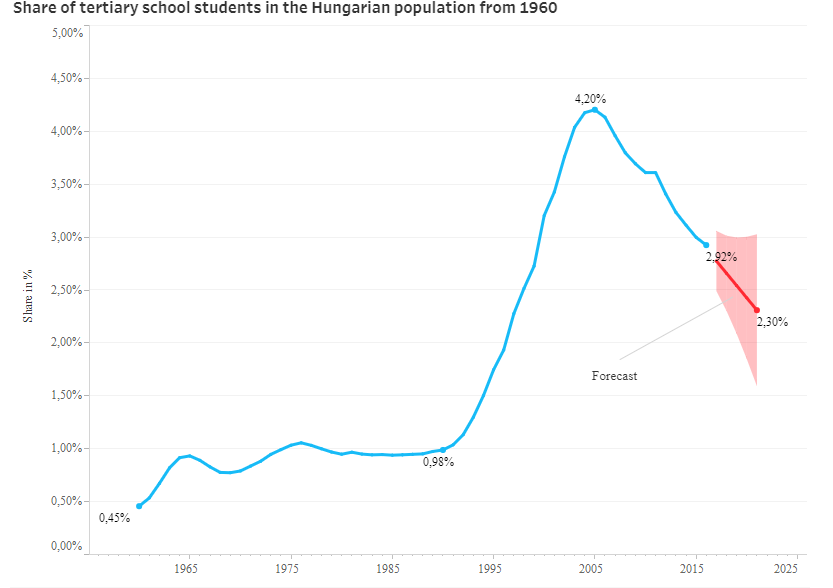The https://english.atlatszo.hu use cookies to track and profile customers such as action tags and pixel tracking on our website to assist our marketing. On our website we use technical, analytical, marketing and preference cookies. These are necessary for our site to work properly and to give us inforamation about how our site is used. See Cookies Policy
Number of students enrolled in tertiary education has been declining in Hungary since 2005
4.2% of the Hungarian population was enrolled in some form of postsecondary studies in 2005, whereas only 2.9% was enrolled in 2016. Átlátszó visualized the related data published by the Hungarian Central Statistical Office.
The Hungarian government announced at the beginning of October that there will be no state-funded places at Corvinus University anymore, starting in 2020. Corvinus, a renowned university of economics and a business school, will offer scholarships funded by foundations, however. This means that not all students will have to pay full tuition.
At the same time, experts are worried that this is the start of a process that will lead to a tertiary education system that will completely eliminate free higher education in Hungary. At the moment, there is a system where part of the students have state-funded places and are studying for free, and others pay tuition. The Ministry for Innovation and Technology denied that this would be their long-term goal.
Eliminating free college and university education for all students in Hungary would further lower the number of students and thus worsen an already serious problem. According to Eurostat data presented by news site G7, Hungary is the only country where the number of college graduates among 25-34-year-olds dropped.
Inspired by this data Atlatszo researched the database of the Hungarian Central Statistical Office (Központi Statisztikai Hivatal, KSH) and visualized data about college and university education.
The first graphic shows you the share of college and university students in the whole population. It proves that the number of college students slowly started to rise in 1989 until 2005, when it started to drop again.
Átlátszó analyzed where the students were living. Between 2005 and 2017 there were huge changes here: the number of students declined in every region but the drop was especially significant in Eastern Hungary.
In Borsod-Abaúj-Zemplén county there were 15,257 students in 2005, but in 2017 there were only 9,935. In Szabolcs-Szatmár-Bereg county there were 12,697 students in 2005, that decreased to 9,536 by 2017. Hajdú-Bihar county has similar data: 12,407 students resided here in 2005, compared to the 9,823 in 2017.
There is a huge drop in the number of students in Budapest as well: from 39,678 the number of students fell to 31,023. This cannot be explained by families moving to the suburbs, which means they no longer technically live in Budapest because the number of students in Pest county only rose by about three thousand in the same period.
The dramatic drop in the number of students is even more clear if we look at the share of students in the entire population of the different counties. Pest county is the only one where the number of students grew in the past 12 years: it grew by 14.3%. If we look at not the number but the ratio, Tolna county lost the most students.
According to OECD data, the ratio of people with higher education degree has slightly risen in Hungary in the past 12 years. In 2005, only 17% of the entire population had a college or university degree, whereas in 2017 24% was a college graduate.
However, even this 24% places Hungary at the bottom of the list in the European Union when it comes to higher education. The first place is shared by the UK and Ireland, where 46% of the population are college or university graduates. Finland is the third with 44%. Italy is the last with 19% of the population holding a degree.
Written by Katalin Erdélyi; Data visualization: Attila Bátorfy
English version by Anita Kőműves and Zsuzsanna Liptákné Horváth. You can read the original, Hungarian-language story here.
Source of the data: KSH, OECD


